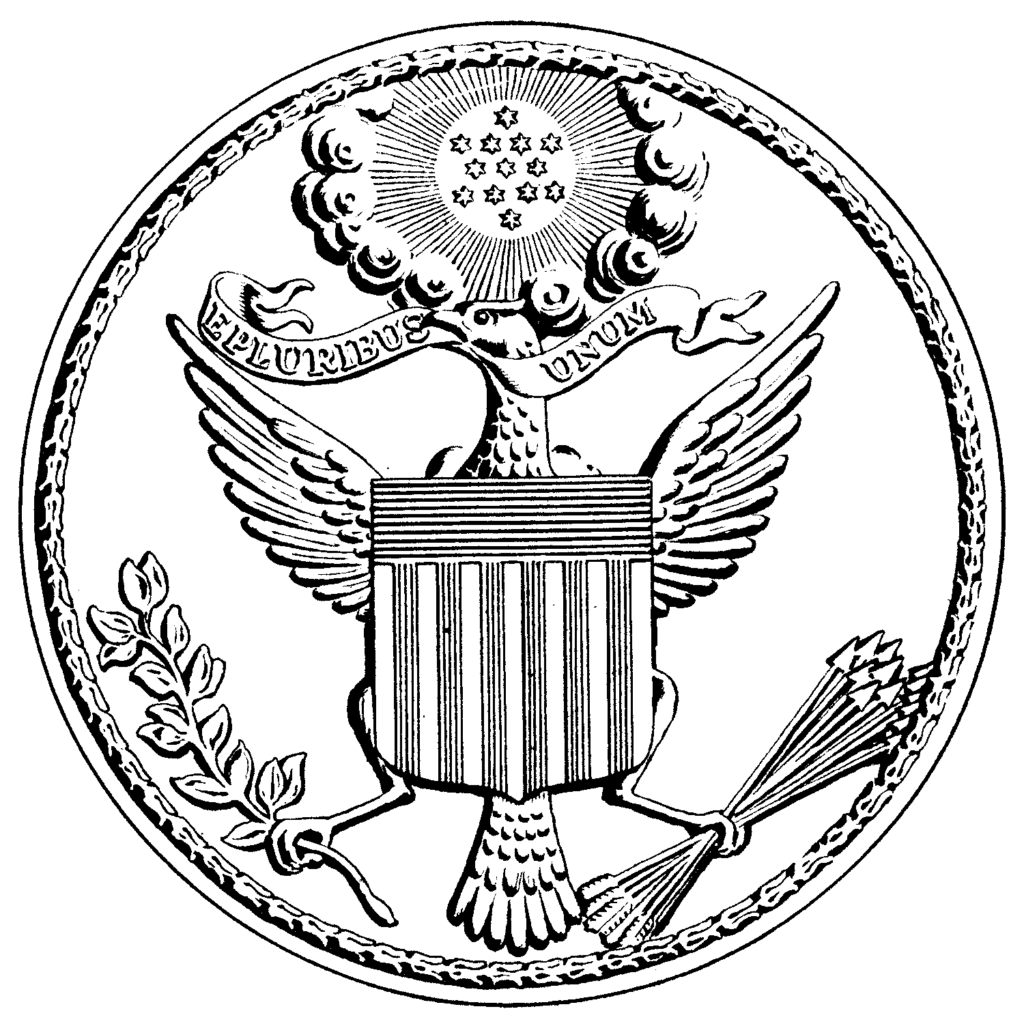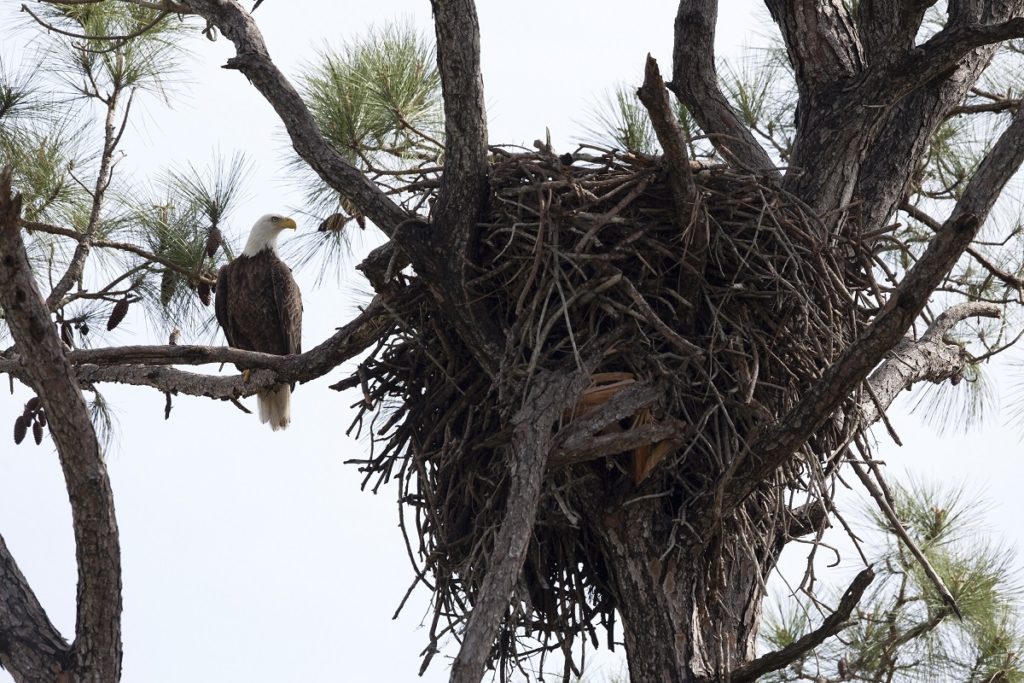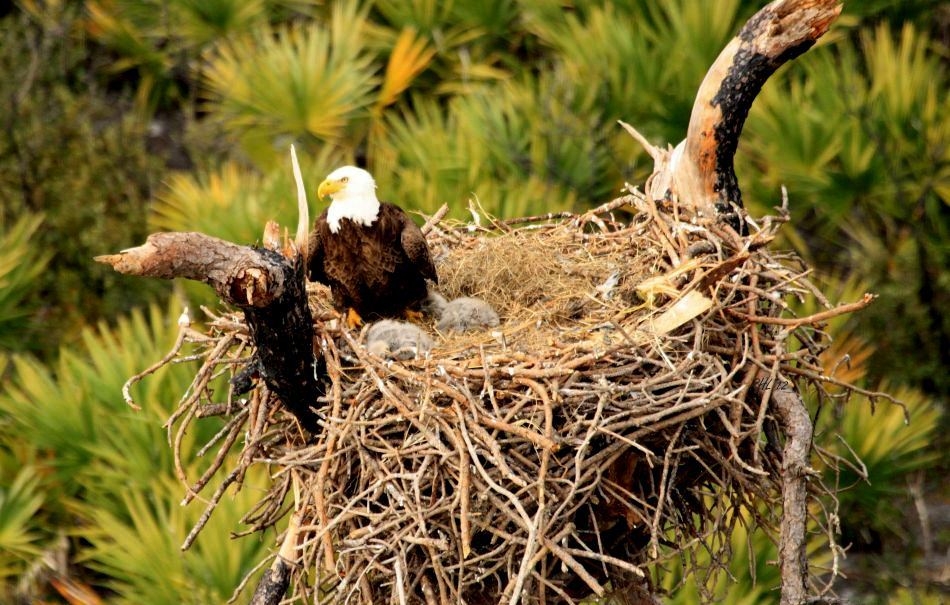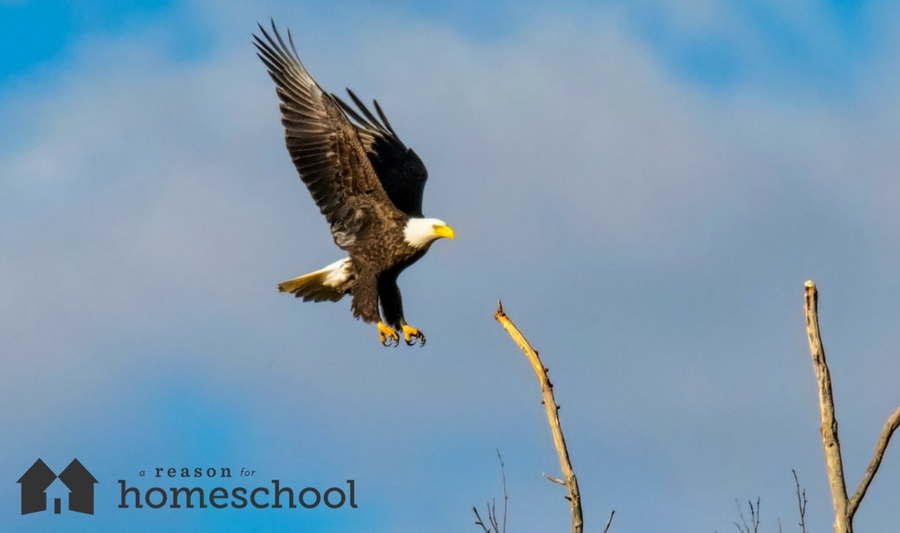Tomorrow, June 20th, is a day set aside to honor a majestic creature that is very familiar to most of us: the Bald Eagle (Haliaeetus leucocephalus). It holds the distinction of being both the national bird and national animal of the United States of America.
On June 20, 1782, the Second Continental Congress selected the Bald Eagle as national emblem of our young nation. At that time, the image of the Bald Eagle was added to center of the Great Seal of the United States.
 Illustration of the 1782 Great Seal, by Walter Manton (1832? – 1895), a U.S. State Department employee.
Illustration of the 1782 Great Seal, by Walter Manton (1832? – 1895), a U.S. State Department employee.
The Great Seal has gone through a number of changes over the past 200-plus years, but the current version remains quite similar to the original:
At the time it was added to the Great Seal, eagles were plentiful in our country. As the years passed, however, there was a steep decline in their numbers, due to several factors:
- Hunting: In Alaska, where more than 100,000 Bald Eagles were killed in the first half of the 20th century, these accomplished predators caught and consumed many varieties of fish. Local fishermen felt they were a nuisance, and hunted them because they were considered a threat to the salmon population.
Hunting eagles became illegal with the passage of the Bald and Golden Eagle Protection Act of 1940. The act has been amended several times. In its current form, it currently prohibits anyone, from “taking” Bald Eagles, including their parts, nests, or eggs, and from disturbing the birds, their nests, or their immediate habitat. There are significant criminal penalties for persons who “take, possess, sell, purchase, barter, offer to sell, purchase or barter, transport, export or import, at any time or any manner, any bald eagle … alive or dead, or any part, nest, or egg thereof.”
In case you are wondering: yes, this includes eagle feathers, even if you find them on the ground. You can potentially be fined thousands of dollars for having an eagle feather in your possession!
- Pesticides: From 1940 – 1950, the insecticide dichloro-diphenyl-trichloroethane (more commonly known as DDT) was widely used in the United States to control mosquitoes that carried malaria. Though the effect was not known at the time, it’s now believed that many birds became infertile over time because DDT (and other pesticides) collected in their bodies. Also unknown was the fact that DDT changes a female bird’s calcium metabolism and affects the hardness of their egg shells. Widespread pesticide use, though well-intentioned, led to a much lower birth rate among Bald Eagles because their eggs often cracked during incubation.
- Habitat Destruction: Eagles are carnivores, and studies have shown that more than half of their typical diet consists of fish. They also hunt small mammals and other birds. Their preferred habitat is near large bodies of water—coastal areas, lakes, rivers, marshlands—with an abundance of prey. They prefer areas with few humans and are very sensitive to disruptions in their habitat, especially during mating and nesting season.
As progressively more land in the U.S. was claimed for houses, farming, and industry, many Bald Eagles (and their prey) were displaced from their usual habitat, with devastating effect on their numbers.
The Bald Eagle population decreased drastically during the first half of the 20th century, and reached a low point of 487 nesting pairs in 1963. On July 4, 1976, the United States Fish and Wildlife Service officially listed the Bald Eagle as a national endangered species. Through conservation efforts that included banning DDT and stiff criminal penalties for killing the birds or disturbing their habitat, the Bald Eagle population gradually recovered and was officially removed from the endangered list in 2007. However, they continue to be protected by not only the Bald and Golden Eagle Protection Act of 1940, but also the Migratory Bird Treaty Act of 1918 and the Lacey Act Amendments of 1981.
Eagles (along with falcons, hawks, vultures, and owls) are known as raptors, or birds of prey. These accomplished carnivorous predators hunt for the majority of their food, although they will scavenge when the opportunity presents itself. They have excellent vision that can spot prey from great distances, powerful beaks, and razor-sharp talons that can tear a smaller creature to pieces.
In the wild, Bald Eagles can live 20-30 years. They reach maturity at 4-5 years, at which point they choose a partner. They mate for life; however, if one of the pair dies, the surviving eagle will choose a new mate.
Mates build a nest (also known as an aerie) together as part of their bonding process. A Bald Eagle’s nest is the largest of any North American bird. The biggest one on record, located in Florida in the early 1960s, measured 20′ from top to bottom and nearly 10′ across, and was the largest tree nest ever recorded in the U.S. Unlike many species, eagles will raise their young in the same aerie for several consecutive years. The oldest known example was used for at least 34 years, but nests generally last around 5 years—tree branches will often break under their weight, destroying them.

After both the male and female work to build their aerie, the female lays a clutch (or single batch) of between 1 and 3 eggs. The incubation period is 35 days. Although it is more often than not the female who remains in the nest, both parents do take turns. One of them is always present to keep the eggs warm, while the other is grooming its feathers, hunting for food, or away for other reasons.
After the eggs hatch, parents tend and feed the fuzzy, hungry eaglets as they grow and develop feathers.

By approximately 9 weeks, they have reached their full-grown size (although their body mass does normally increase as they continue to develop). Bald eagle young are usually ready to take their first flight by 10-12 weeks of age, and spend the next several months perfecting their flying skills. During this time, they may do some hunting or scavenging, but to a great extent, their parents continue to provide food to sustain them. Before they have reached 6 months of age, however, the parents will no longer share food with their offspring and will instead force the young eagles to hunt on their own.
A juvenile eagle’s feathers are brown and white in varying amounts; generally speaking, their feathers are lighter brown in the early days and darken over time. (Visit this site to see photographs of a Bald Eagle from ages 1-5 years.) When they reach maturity, at around 5 years, the Bald Eagle has a solid brown body, with a white head and tail. Their legs, feet and bill are vivid yellow.
Bald Eagles are, of course, not actually bald. Their name came from the old English word balde, which meant “white” and referred to the solid white feathers on the eagle’s head.
The average adult Bald Eagle wingspan is between 6 and 7.5 feet, and their body length averages 35-38 inches. Their size varies according to geography; in colder northern climates, the birds are larger (in keeping with Bergmann’s Rule). In Alaska, for example, an adult female might weigh as much as 18 pounds. Meanwhile, in Florida, mature females weigh between 8 and 12 pounds. Weight also varies according to gender; males weigh approximately 25% less than females in any given geographical area.
The eagle’s call is, for a bird of its size, surprisingly weak. (You can hear it here.) In fact, the sound many of us may associate with Bald Eagles is very likely not authentic. Frequently, when an eagle is shown in advertising or other media, audio of another bird (often a red-tailed hawk) is dubbed over the real Bald Eagle call.
Eagle habitats exist in every state except Hawaii. If your family wants to observe them in the wild, a directory of Bald Eagle viewing locations can be found at the American Bald Eagle Information website. (Note that the detailed directory is not available in nesting season, because it is harmful—not to mention illegal—to disturb them during that time. You can still see state-by-state reports from individuals who have sighted Bald Eagles.) From the comfort of home, you can also view a number of nests via 24/7 webcam feed.
Want to study Bald Eagles with your children?
- The National Eagle Center has lesson plans for students at all levels.
- More lesson plans from the Conserve Wildlife Foundation of New Jersey.
- Click HERE or HERE (free with sign-up/membership required) to download Bald Eagle coloring sheets.
While most states do acknowledge the Bald Eagle in some manner on June 20th, the American Eagle Foundation is trying to garner enough public support to establish a permanent, nationally-recognized day of celebration. This would require passing a Joint Resolution by both the U.S. House and Senate. The foundation is encouraging a letter-writing campaign to make this happen—talk about a great summer civics activity for your kids! Please visit the American Eagle Foundation website for details of how you can help honor this incredible creature, on both state and national levels.
